Recent Storm Damage Posts
Tips for Tackling Flood Emergencies | SERVPRO of Greater Sussex County
3/15/2024 (Permalink)
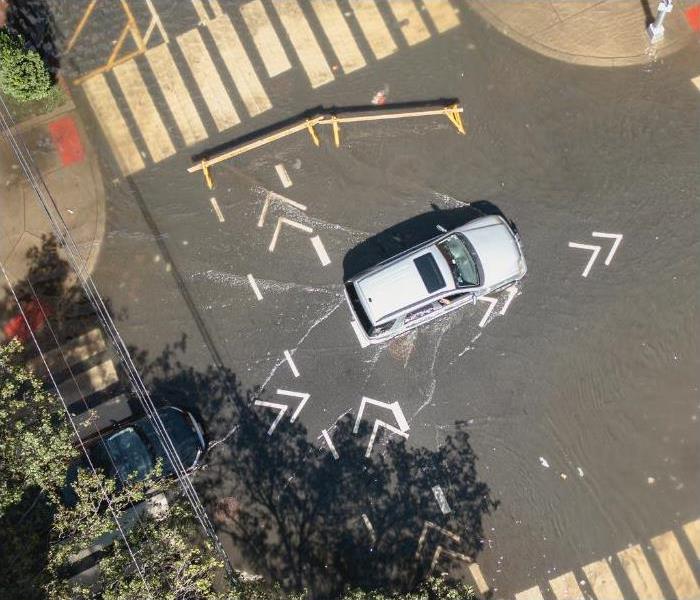 Don’t let flood damage slow you down! SERVPRO of Greater Sussex County is Here to Help® whenever disaster strikes.
Don’t let flood damage slow you down! SERVPRO of Greater Sussex County is Here to Help® whenever disaster strikes.
When it rains, it can really pour in the Vernon area! The spring season can bring some gentle rainstorms, but it can also bring strong thunderstorms that end in flooded roads and, unfortunately, flooded basements.
No one wants to think about the possibility of experiencing a flood in their own home, but it is really common. Because of that fact, it is important that you have a plan in place ahead of time so you can stay safe when the water comes rushing in.
Focus on Safety
Did you know that flash flood warnings can be issued even before it starts raining? The majority of flood issues stem from weather situations, but they can also be caused by broken dams or levees or even if a main water line bursts in the middle of town.
No matter the situation, you should heed all flash flood warnings and take them seriously. Even just a few inches of fast-moving water can knock you down, so avoid any areas in question and try to stay off the roads when you can.
If your home is located in a flood zone or you know that your lowest levels tend to get wet when it rains heavily, consider turning off electricity to that space and move anything of importance to a higher level. Locate your emergency kit and weather radio, then gather your family in a safe area of your home to wait out the situation.
Tackling Floodwater
If water starts to infiltrate your home, do your best to stay calm and keep your family out of the water. Floodwater can harbor dangerous substances like storm runoff, toxic chemicals and even sharp debris, so stay out of the water so you can stay safe. Wear sturdy boots and protective gloves if you must navigate the area that is flooded.
Once everyone is safe and out of the affected area, get us on the phone as soon as possible. We know that the longer flood water sits in your home, the worse your situation can become.
We will gather up our supplies and materials and be on our way to you as quickly as possible! In the meantime, grab your phone and take some pictures of the damage so you can get your insurance claim process started right away.
Restoring and Repairing
We know that the most important part about flood restoration is removing the water, which is exactly what we do upon our arrival. We will clean and dry up the standing water with our wet/dry vacuums, mops, towels and air movers, and we will use thermal cameras to detect hidden moisture behind your walls. Once the water is removed, we can turn our attention to any repairs that need to take place.
Water is notorious for seeping and leaking into walls and floors, which can leave them swollen or warped. Our team will address these repairs with precision so we can return your home to its pre-flood condition as quickly as possible.
Flood situations should always be dealt with quickly. Contact us today to learn more about our flood restoration process.
Determining the Scope of Flood Damage in Vernon Homes
8/9/2022 (Permalink)
 Don't let flood damage take over your property, Call SERVPRO of Greater Sussex County at (973) 383-2024.
Don't let flood damage take over your property, Call SERVPRO of Greater Sussex County at (973) 383-2024.
SERVPRO Handles Flood Restoration Challenges in Vernon
Flooding is usually destructive to properties. However, flooding incidents vary in many ways, which affects the time, costs, and efforts needed to restore your Vernon home to its pre-damaged state. Seeking help from an experienced service provider can help you manage flood damage conveniently.
The variations in flood damage outcomes in Vernon properties are primarily attributed to the causes. An incident sparked by torrential rain breaching the roof or other structural areas would be different from a situation such as a flash flood because of the water volumes and other dynamics involved. SERVPRO is well organized, so we can avail the equipment and trained staff to manage the problems that flooding causes.
The scope of a flooding incident can be identified by the level of
- Contamination
- Submersion
- Structural degradation
Your property might be mildly or heavily contaminated after flooding. Since hazardous substances are invisible, the level of physical soiling accumulating on surfaces is not an indicator of contamination. Our SERVPRO crews consider other factors, such as the water source because groundwater is laden with chemicals and biohazards. We can also use specialized tools such as luminometers to test for contamination. Depending on the information we find, we can take appropriate steps such as containment and applying chemical agents to control the contaminants.
Extracting Stagnant Water
The level of submersion can range from just a few inches to a couple of feet. The higher the water rises, the more challenging restoration becomes because of the affected things. At a depth of 6 inches, floor and wall materials like wooden floorboards, carpets, drywall, and insulation are affected. If the standing water rises over one foot, it affects utilities like HVAC, furnaces, and electrical outlets. If it reaches over three feet, it can affect the foundation. The longer the house remains submerged, the worse the damage gets. SERVPRO expedites extraction where possible.
Handy flood water extraction tools
SERVPRO of Greater Sussex County offers the help you need to resolve flood damage conveniently. Call us at (973) 383-2024. We’re Faster To Any Size Disaster.
Quickly Handle Flood Damage After a Sparta Storm Event
5/4/2022 (Permalink)
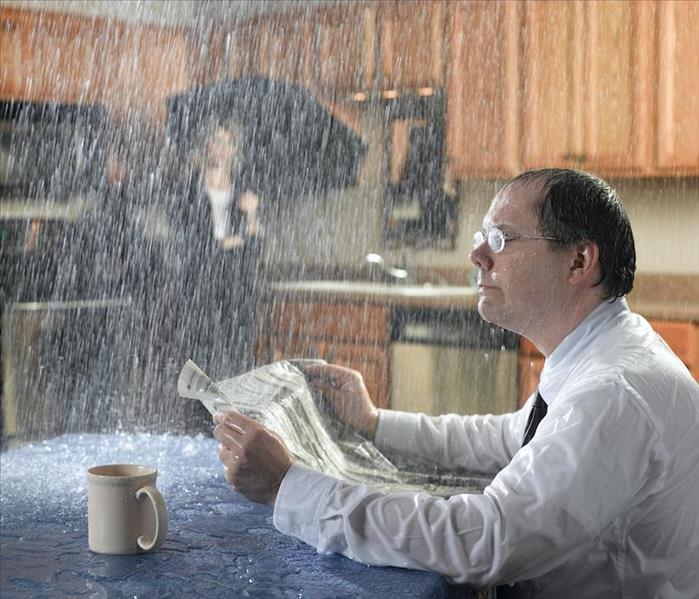 Flood damage restoration services by SERVPRO are top-notch. We are ready at a moment's notice to help you out. Call now!
Flood damage restoration services by SERVPRO are top-notch. We are ready at a moment's notice to help you out. Call now!
SERVPRO’s Storm Flood Damage Response Team is Here 24/7 in Sparta
Storm damage may impact your Sparta home in countless ways, some of which someone without proper training may not realize until secondary damage sets in. With DIY storm flood cleanup, many home and business owners solely focus on the significant tasks such as water removal and cleaning some of the areas with heavy soiling. However, water mitigation efforts must also commence to locate hidden moisture and address possible structural damage. This is where our IICRC-certified water restoration technicians (WRT) at SERVPRO are here to get the job done!
SERVPRO follows our perfected protocols to handle flood damage after Sparta storms ravage the area. Whether you have a leaking roof from storms or floodwater infiltrating your interior, we formulate a plan to address every aspect and never leave anything unattended. This is detailed water removal services, odor control, drying, and reconstruction – all available 24-hours a day.
Floodwater coming in from the outside could have any number of contaminants. Therefore, we contain the flood loss zone, treat standing water with disinfectants, and ensure our crew wears personal protective equipment (PPE) for safety. We not only pull up standing water and clear out debris but we also:
- Follow the path of water migration to ensure all impacted areas get addressed
- Inspect subflooring and baseboards to handle hidden moisture, pulling up any unsalvageable materials
- Handle contamination that may have traveled down into your HVAC system’s ductwork
Cleaning is Critical With All Floodwater Events
To get the Certified: SERVPRO Cleaned seal of approval, our team ensures contents and surface cleaning get handled with precision. We address bacterial pathogens and other contaminants with the help of specialized, EPA-registered cleaning agents and biocides. All surfaces are cleaned, sanitized, and deodorized!
Call (973) 383-2024 or request help online when you need SERVPRO of Greater Sussex County for flood damage cleanup after a storm. Your property will be “Like it never even happened.”
Leave Your Flood Damage Issues to Pros in Vernon
3/1/2022 (Permalink)
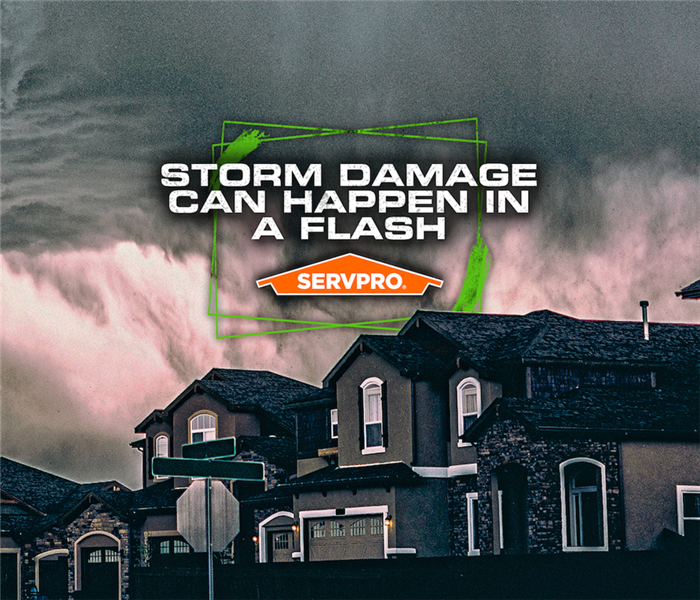 SERVPRO flood damage remediation technicians have all the tools and training needed for your home. Call now for fast and immediate service.
SERVPRO flood damage remediation technicians have all the tools and training needed for your home. Call now for fast and immediate service.
SERVPRO is Here for Vernon Residents with Storm Flood Damage
Flooding to your property is overwhelming, devastating, and often leaves you not knowing where to begin with the cleanup. It is common to think all is lost, but there are ways to remove standing water and salvage belongings. All it takes is a highly-trained eye and careful techniques – which is where we come in at SERVPRO. We are here 24/7 when Vernon residents have flooding and storm damage to address on their properties. We follow detailed restoration and safety protocols to get you the results you need quickly and efficiently.
Flood damage in Vernon after recent storms often means contaminated water coming into your home riddled with debris and muck. Once you call SERVPRO, we mobilize a team to head to your property within hours of initial contact so that we can begin assessment and mitigation protocols.
Handling Debris (Muck) During Flood Restoration
Flooding and stormwater bring debris, silt, and other solid matter into your home that must get removed along with the standing water. SERVPRO’s water restoration technicians (WRT) target mud and debris using our muck-out protocols. This reduces any potential pathogenic threats and contaminants present within the workspace.
Contents Cleaning/Restoration
All items that come into contact with contaminated storm floodwater must get disposed of or cleaned. We determine salvageability through thorough assessment, often using our pack-out services to relocate items off-site for safe, effective cleaning. This also frees up space for our team to bring in equipment to facilitate water removal services, then dry and sanitize all surfaces. As our contents cleaning team works on your interior belongings, items go through the following steps:
- Testing for color-fastness
- Meticulous surface cleaning
- Complete drying
- Sanitizing
- Odor control/deodorizing
- Storage until the restoration project is complete
We’re Faster to Any Size Disaster! Call us at (973) 383-2024, and our team from SERVPRO of Greater Sussex County can get started on your flood damage needs!
Why Do Vernon Property Owners Trust SERVPRO After Flood Damage?
2/16/2022 (Permalink)
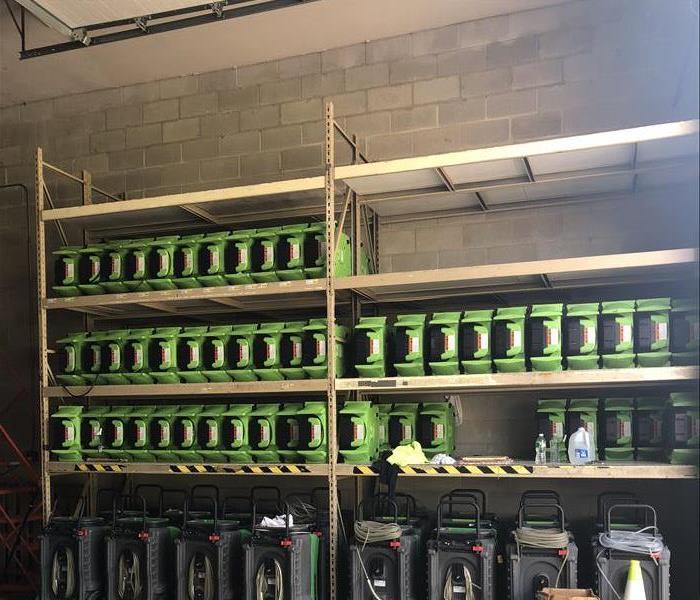 Vernon flood-damaged properties benefit from SERVPRO's extensive inventory of drying equipment like air movers and dehumidifiers
Vernon flood-damaged properties benefit from SERVPRO's extensive inventory of drying equipment like air movers and dehumidifiers
SERVPRO techs dry flood damaged Vernon homes efficiently
One of the most important things to limit the effect of flood damage to your Vernon home is to get it dry as soon as possible. Once the SERVPRO techs remove the standing water from the property, they use dehumidifiers and air movers to control the residual moisture in the structure.
SERVPRO techs use dehumidifiers to restore flood damage to your Vernon home as they can reduce the humidity of the air and speed up the drying process. However, the choice and placement of a dehumidifier are equally crucial for effective drying. The SERVPRO crew chief decides the type of dehumidifier needed based on PPD (pints per day) value. PPD is the number of pints of water that a given dehumidifier can remove from the air.
How do SERVPRO techs increase the efficiency of dehumidifiers during water cleanup in Vernon?
SERVPRO techs strategically place dehumidifiers to maximize their efficiency during water clean-up from your Vernon home. The exhaust of the dehumidifier is often directed towards an air mover so that the warm, dry air can be circulated throughout the structure.
SERVPRO restorers use ducting with dehumidifiers to direct hot, dry air from the dehumidifier to various areas. Techs use two types of ducting with dehumidifiers-
- Flex ducting: Techs attach this ducting to the dehumidifier's intake with a zip-tie.
- Lay-flat ducting: Such type of ducting is usually attached to the exhaust and allows the restorers to direct the airflow to specific areas.
How do techs keep an eye on the progress of restoration work?
Techs use moisture sensing instruments like moisture meters and IR cameras to determine whether the drying goal is met.
Call SERVPRO of Greater Sussex County at (973) 383-2024; our restorers are available 24/7 to answer your calls.
What Does Frozen Pipes and Ice Damming Damage in Sparta Homes Constitute?
12/23/2021 (Permalink)
 Frozen or burst pipes can be a real problem in your home, call SERVPRO for assistance right away.
Frozen or burst pipes can be a real problem in your home, call SERVPRO for assistance right away.
SERVPRO Helps Identify All Structural Damage and Any Underlying Issues That Cause the Problem
Frozen pipes and ice dams pose many challenges in homes. Sudden freezing causes pipes to rapture, while the pressure from ice dams lifts shingles allowing water to leak into a structure. Blizzards and winter storms can readily expose you to such incidents, leaving significant water damage in your Sparta home.
When you notice frozen pipes and ice damming damage in your Sparta home, it is usually too late to prevent it from happening. However, there are other issues you can prevent, especially when assisted by a professional restoration company like SERVPRO. Early identification of all the damages likely to develop after such an incident helps with planning.
Some of the Damages to Expect Include:
- Physical pipe damage necessitating replacements
- Damage to shingles and other roof sections
- Wet structural materials like insulation, panels, and structural supports
The level of damage can vary, so any action taken should not be based on assumptions. For instance, if you suspect frozen pipes after an ice storm, you should confirm the situation or use a protective approach when instituting thawing procedures. Our SERVPRO technicians can help with evaluation and take preventive steps such as turning on faucets in the house and turning off the water supply at the mains. Such steps help with safe thawing and protect the house if any ruptured pipes are not identified.
Apart from damaging structural elements through water intrusion, the development of ice dams shows problems that need to be resolved around the house. Some of the most common issues are insufficient insulation to the attic, improper air exhaustion from areas such as the bathrooms or kitchen, and improper sealing or duct insulation. Therefore, apart from removing the ice dams, it is essential to address the underlying issues to prevent a recurrence.
SERVPRO of Greater Sussex County can help you manage freezing and thawing trends in various sections of your home, preventing frozen pipes and ice damming damage. Call us at (973) 383-2024. We’re Faster To Any Size Disaster.
Can SERVPRO Handle Storm Damage Cleanup in Vernon?
12/7/2021 (Permalink)
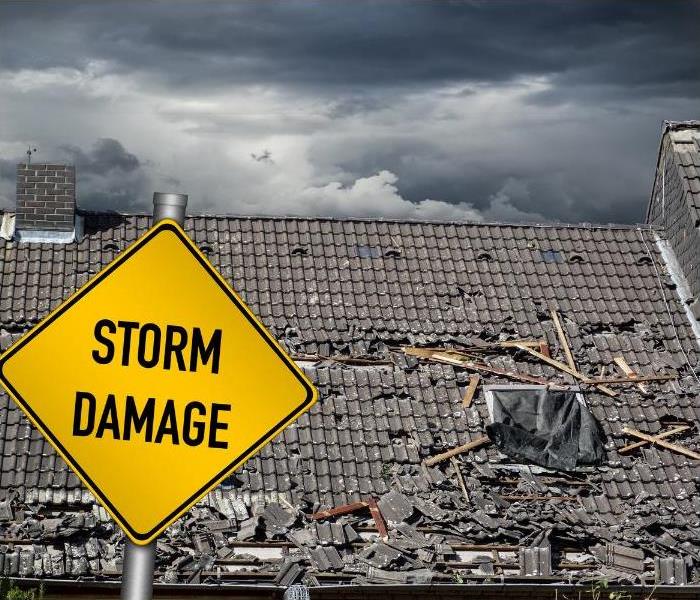 If your home experiences storm damage, contact SERVPRO. We are Here to Help.
If your home experiences storm damage, contact SERVPRO. We are Here to Help.
Quick Response and Efficient Technique During Storm Damage Cleanup Makes SERVPRO the First Choice of Vernon Homeowners
Water damage after a storm can cause widespread mayhem on your property that warrants professional restoration. Restorers like SERVPRO have the experience, training, and equipment to safely carry out storm damage cleanup of your Vernon home and get the situation under control. One of the most common effects of a storm is broken pipes that can potentially cause flooding on your property.
SERVPRO technicians prioritize water removal and drying during storm damage cleanup of your Vernon home to prevent any long-lasting issues. The first step in the water mitigation process is to remove any standing water, if present, from the property. SERVPRO techs accomplish this by using state-of-the-art water removing pumps. Once restorers remove the water, the next step is to ensure that the structure is dried quickly to minimize the chance of any long-term issue.
How do SERVPRO Techs Dry Structural Cavities During Water Cleanup of Your Vernon Home After a Storm?
It can be challenging to remove residual moisture from structural cavities in your Vernon home. SERVPRO techs use various ventilating and drying systems to direct airflow into wall cavities. The goal is to replace the moist, cold air with warmer, drier air to speed up the drying process.
Drying systems used to remove water from structural cavities can be different. Some of the drying systems that SERVPRO techs use during water damage restoration include vents attached to air movers. The techs direct air into the structural cavities by drilling small holes in walls, ceilings, or under the cabinets.
Technicians apply either negative pressure or positive air pressure into the cavities, depending on the situation. Positive pressure is achieved when air is pushed into a cavity, while negative pressure is achieved when air is pulled away from a cavity.
Call SERVPRO of Greater Sussex County at (973) 383-2024; We are available round-the-clock to help and assist you.
What Processes Remove Floodwater from Damaged Vernon Homes?
11/30/2021 (Permalink)
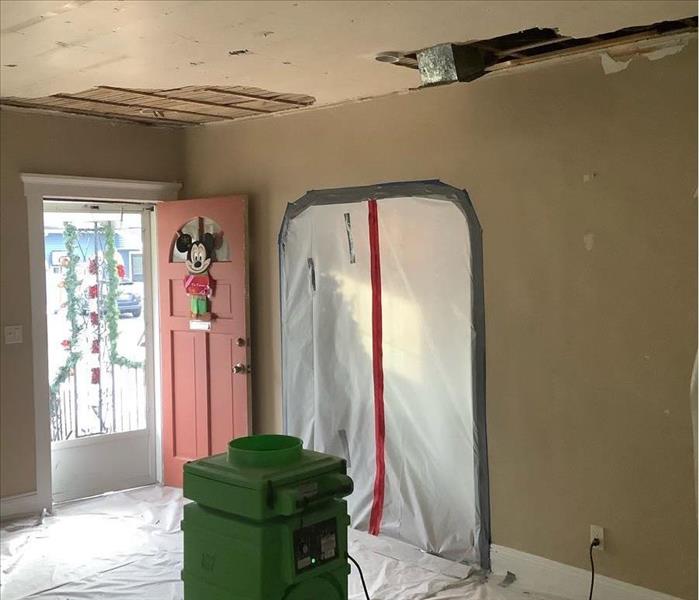 Storm damage from the roof to the interior calls for SERVPRO's talented experts to mitigate the damage as shown in this Photo
Storm damage from the roof to the interior calls for SERVPRO's talented experts to mitigate the damage as shown in this Photo
Fast extraction and drying are vital to recovering Vernon properties after flooding.
Flooding can be a rapidly forming and highly destructive event for homes and businesses throughout Sussex County. Our professionals have a rapid response for storm and flood restoration, making us the ideal choice to help when these disasters strike.
Stopping the Intrusion of Water
Before much water can get removed and flood damage in Vernon homes appropriately addressed, the penetration point allowing water intrusion must be identified. From basement vulnerabilities in the foundation walls to holes in the roof, flooding can happen quickly with physical openings in the exterior of a residence.
Clearing Standing Water
One of the largest undertakings after flooding exists in your home is to remove standing water from the flooring throughout the property. Flood water can be a challenge to remove, especially when it includes solids and debris. Responding technicians must be selective in the water removal tools necessary for this process, as not all extractors in our inventory can discharge waste. Ultimately, extraction comes down to a combination of several units, including:
- Submersible pumps
- Wet vacuums
- Weighted extractors
- Carpet wands
- Squeegee wands
- Trash pumps
Preventing Trapped Moisture from Causing Greater Harm
Beyond standing water, trapped moisture inside structural cavities and porous materials can also prove destructive to the household. We have special equipment designed specifically to promote evaporation in wall cavities and water removal devices like weighted extractors or carpet wands to pull trapped water from sensitive materials.
Flooding is one of the most rapidly developing and potentially destructive events that homes are likely to face in their existence. Our SERVPRO of Greater Sussex County team understands how fast these disasters can spread through an affected house, making direct objectives to remove water critical to restoring a property to preloss condition. Give us a call today at (973) 383-2024.
2021 Atlantic Hurricane Season Outlook
8/1/2021 (Permalink)
The Atlantic Hurricane Season officially started on June 1, but the "heart" of the Atlantic Hurricane season runs from August to early October. According to AccuWeather meteorologists, the 2021 hurricane season will once again be above normal, albeit less severe than last year.
They still urge businesses and residents in hurricane-prone areas to prepare now.
In 2020, of the 30 named storms, the US experienced 12 direct strikes, surpassing the previous record of 9 in 1916. They are predicting that 2021 will produce 16-20 named storms, including up to 10 hurricanes, with 3-5 being major hurricanes and having an impact on the US.
To understand the changes that have occurred, looking at 30-year averages, from 1961 to the current"
- 1961 - 1999
- 10 Named Storms
- 5.7 Hurricanes
- 1.9 Major Hurricanes
- 1991 - 2020
- 14.4 Names Storms
- 7.2 Hurricanes
- 3.2 Major Hurricanes
Noteworthy is that water temperatures in the Atlantic are already above normal, which is a strong predictor of an elevated hurricane season.
Because of the consistent upward trending of these predictors, the National Hurricane Center is seriously considering moving the official start date to May 15 in future years.
What does this mean?
It means to begin preparing in the spring so that you are ready when and if a hurricane does strike.
Contact us at 973-383-2024 if you have a service need or click here to visit our website to learn more about SERVPRO of Greater Sussex County's System Services.
Prepare NOW For Storm Wind Damage
5/1/2021 (Permalink)
As we approach hurricane season, now is the time to begin to think about storm damage, even here in the northeast. Preparing your business or home now can help prevent unnecessary damages to your building when that storm hits.
Wind can come in the form of hurricanes, tornadoes, cyclones, microbursts, or downdrafts. It can be valuable to understand the impact of high winds and how to best protect your business, home, and property from wind damage. There are many ways to reinforce a building against wind damage — some are simple enough to DIY while others may require a pro.
First, inspect your building's roof, siding, windows and doors, and even landscaping to identify vulnerable spots. Replacing many of these items can be very expensive, so this may not be an option. However, being prepared to install temporary protection in the event of a storm that brings high winds and heavy rains may be all you need to do. No solution is perfect; mother nature knows that, but doing nothing to prepare is not the best option either.
Doors
When considering the role doors play in protecting buildings from high winds, it is customary to think about our exterior doors first. They are the doors that provide the first line of defense from high winds and blowing debris.
While wind-resistant doors and break-resistant glass play a significant role in fighting winds, interior doors are also essential. In hurricane winds or when a tornado may be imminent, all doors and windows, including every interior door, should be closed. This can prevent pressure build-up inside a building, leading to losing a room. Closing interior doors will also help compartmentalize damage from wind or rain if there is a breach in the exterior of a building.
Impact-resistant doors are the best possible solution, but if these are not installed, then:
- inspect doors for any cracks or missing or damaged hardware.
- Ensure no air leaks around the door and replace standard hinge screws with longer, stronger screws that will reach into the wall frame.
- Ensure the threshold seals the door bottom and is screwed deeply into the floor.
- Add a deadbolt to exterior doors that extend a minimum of one inch.
- If you have French-style double doors, make sure they are refitted with bolts that extend at least an inch into the floor.
- Finally, reinforce doors (and windows) with sheets of plywood when a hurricane approaches. This can be cost-effective and should be planned.
Windows
Many items in a yard can quickly turn into projectiles during high winds. These items make a building's windows vulnerable during high winds, especially when standard glass is used.
Even a small branch or piece of flying debris can start a landslide of damage once a window is cracked. As winds continue to put force on the broken window, the break can become more extensive and even cause the complete failure of the window. Winds and rain now have even greater access to the building's interior, creating further damage. Once winds enter a space, the entire structure, including the roof, is at risk.
There are only two options when it comes to providing better window protection. One is to cover or reinforce windows, and the other is to upgrade windows to high-impact glass.
Roofing
The roof is one of the most significant parts of a building. It is helpful to think of it as a combination of materials that protect your home from the elements and help keep warmth and cool air inside.
The roof is susceptible to damage in high winds for various reasons. As a roof ages, shingles can become brittle and lose adhesion to the structure. Older roofs aren't reinforced as well as more modern structures and are more easily damaged. While a roof is large and heavy, it can be no match for high winds as elements get peeled away, or the entire roof structure may even be lifted away. Of course, once the roof has been compromised, wind and water can enter the interior of the building, and the entire building will be at risk.
There is no additional protection you can provide for a roof except repairing damaged sections or replacing the roof entirely.
Garage Door
A garage door is typically the most significant moving part of an entire home. Generally speaking, garage doors are designed to move upward and downward. Under the stress of high winds, they can and do fail. This can cause a chain reaction of destruction and damage to a home once wind and moisture are introduced to the area.
Check to see that all seals around the door are good enough to prevent winds from entering. Protecting a garage door can be done with special braces or installing plywood as you would with windows.
Home Siding
Another area of a home that should be of concern in high winds is the siding. Like the roof, windows, and doors, keeping a home's siding inspected and properly maintained will go a long way in maintaining its integrity in a windstorm. Like those other areas, the key is preventing the wind from getting a foothold behind the siding, allowing it to tear it off of the structure.
Preparing the siding of a building is to repair damages sections and gaps where wind could enter or complete replacement of the system.
Landscaping and Outdoor Items
An important component of protecting a building in high winds is minimizing the potential projectiles that can become airborne. These projectiles can result from trees and limbs and from an assortment of yard items.
Depending on how much warning you have prior to a wind event, these items should be safely stored. Larger items which cannot be stored should be disassembled and stored, or at the very least turned upside down and secured to the ground. You should consider every item not secured in their outdoor spaces as a potential projectile.
Taking Shelter Indoors
The safest place in a building during a high wind event is generally the same; an interior room on the lowest level of a structure, away from windows and exterior doors. In some cases, this may be a basement or a first-floor interior closet or bathroom.
Be sure to take a battery operated radio or weather radio with you along with a flashlight. Blankets may offer additional protection and in severe cases, mattresses can be used to provide cover. If an interior bathroom is used, the tub can provide additional protection.
When disaster strikes your home or business, choose the #1 ranked in Restoration Services. Choose SERVPRO of Greater Sussex County.
Contact us at 973-383-2024 if you have a service need or click here to visit our website to learn more about SERVPRO of Greater Sussex County's System Services.
Stopping Ice Dams
4/7/2021 (Permalink)
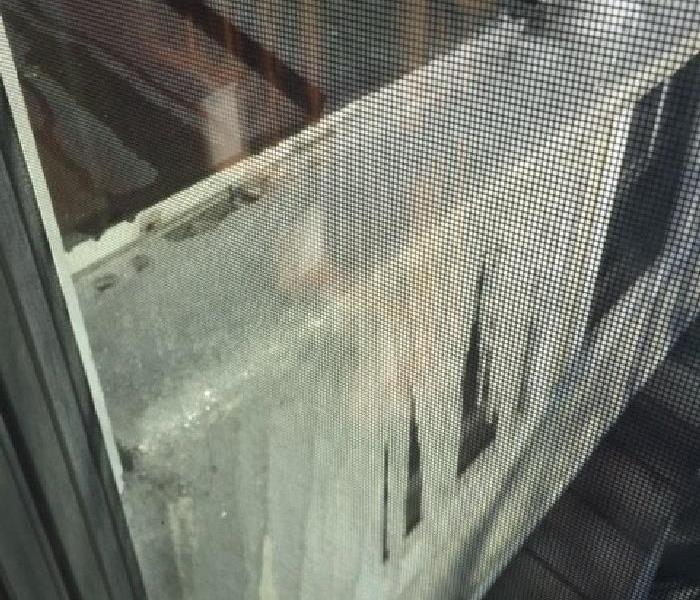 ice dam, water damage
ice dam, water damage
Seems a little late in the season to be talking about Ice Dams, but now is the time to correct some issues which may have caused them.
Ice Dams are thick ridges of solid ice that build up on the lower part of your roofline, preventing melting snow from reaching your gutters.
First, we need to understand how an Ice Dam forms:
- Heavy snowfall and sustained cold weather prevents roof-bound snow from gradually melting away. This leaves an enormous amount of snow on your roof.
- Heat then collects in your attic and warms the roof, except the eaves.
- Snow then melts on the warm roof and then freezes as the melted water approaches the cold eaves.
- This water then re-freezes. Ice accumulates along the eaves, forming a dam. Once this ice dam forms, it blocks ongoing melting snow from escaping into your gutters.
- Melted snow water has nowhere to go except back up the roofline, under the shingles, and finally into your home.
Preventing Ice Dams
Following are some steps you can take now to prevent Ice Dams in the future. Speak with a contractor for each, if you're not handy.
- Use Heated Cables: heated cables, placed along your roof edge, will help keep snow melting before it freezes
- Ventilate Eaves And Ridge: Place baffles at the eaves to maintain a clear path for the airflow from the soffit vents.
- Cap the Hatch: Cover unsealed attic hatches with weather-stripped caps made from foil-faced foam board held together with aluminum tape.
- Exhaust to the Outside: Make sure that the ducts connected to the kitchen, bathroom, and dryer vents all lead outdoors through either the roof or walls.
- Add Insulation: Make sure attic insulation is not missing in any area. This will keep heat from entering the attic space from your home. The attic should not be a heated space.
- Flash Around Chimneys
- Seal and Insulate Ducts
- Caulk All Penetrations
If you do experience an Ice Dam situation, here are some quick fixes to prevent further damage until the ice and snow can be removed from the roof.
- Rake the Snow before it can accumulate and freeze. There are long handle snow rakes you can purchase.
- Blow Cold Air at the source. This will help to re-freeze the ice dam and prevent water from entering the home until the roof can be cleared.
- De-ice the problem area by filling an old pantyhose with calcium chloride and placing it where the ice dam has occurred. This will cause a gradual melting of the ice.
Finally, DON'T:
- Throw rock salt on the problem. This could damage the roof shingles and shrubs.
- Hack away at the ice. You could damage your roof and this is a dangerous fall hazard.
Contact us at 973-383-2024 if you have a service need or click here to visit our website to learn more about SERVPRO of Greater Sussex County's System Services.
Places To Find Cash After A Disaster
12/26/2020 (Permalink)
It happens when you least expect it, and you certainly don't plan for it. The natural disaster, like a flood, fire or any other type of personal catastrophe that leaves you in dire need of liquid funds.
Self preservation requires cash. If you’re hit with an emergency and need to find cash fast, of course, the first place to look are your bank accounts. If these funds are not sufficient, then look to these resources.
1. Family and Close Friends
If you need to find cash fast, ask your family and friends. If they can help, remember to always treat this as a loan and never treat it casually.
If you need to, attach an interest rate and a payment time frame, as you would any official loan from a financial institution. This is important because your family or friend have to charge you something for the transaction to be considered a loan and not a gift that could have tax and estate planning implications.
2. The Government
FEMA is able to provide disaster assistance for such needs as temporary housing, home repair, disaster-related medical expenses, vehicle damage and cleanup costs. Another source, the U.S. Small Business Administration (SBA) offers federally subsidized loans for renters, private nonprofit organizations and home and business owners.
Here's the catch...to qualify for either a FEMA or SBA loan, you must live in a federally declared disaster zone and file a claim with their insurance company first.
3. Life Insurance
Permanent life insurance policies are great resources because they’re readily accessible funds. The can be borrowed against without having to qualify for a loan, and you can pay a policy loan back on your own schedule.
However, rules will vary with insurance providers. Many require policyholders to own their policies for a few years before they can qualify to borrow. You’ll also be charged interest for taking out a policy loan.
4. CDs, Savings Bonds and Mutual Funds / Stocks
CD's: You can take your money out of a CD, but you’ll likely pay a penalty. Sacrificing some earnings is a relatively insignificant compared to paying interest rates on a life insurance loan.
Savings bonds: Savings bonds are another quick cash resource. You might need to pay a three-month interest penalty if a bond is redeemed too early though. In both cases, of course you’ll pay income tax on any interest earned.
Mutual Funds: You can sell stocks as well as mutual funds and annuities. If you take this route, consult your financial adviser about likely tax issues and penalties.
5. College 529 Savings
You may need to borrow from your future to pay present obligations. You 529 College Savings Account is a good resource for this. However, according to the Securities and Exchange Commission, those who withdraw funds out of a 529 plan for non-qualified education expenses will pay income tax and a 10 percent penalty on any earnings.
6. Retirement Accounts
Retirement accounts can be used to fund personal financial needs. It's important to understand the long term personal retirement planning impact. So plan accordingly and know the difference between a Roth IRA and a traditional IRA.
Roth IRA holders may withdraw their own contributions — not earnings — without tax or penalty.
Traditional IRA holders may start taking penalty-free distributions on their accounts if they begin taking regular distributions, but specific rules apply. You’ll pay income taxes and a 10 percent penalty on the taxable amount if you’re under age 59½.
7. A 401(k) Loan
A 401(k) loan is usually a better option than using a 529 or IRA loan.
401(k) holders can borrow up to half of their account balance, up to $50,000, tax-free, but, in most cases, funds must be repaid within five years.
The shortcoming is that you have to stay with your current employer for the duration of the loan period. If you leave your job, you’ll have 30 to 60 days to repay the loan or face penalties.
Before pulling funds from any long-term investment, read the fine print and always consult your tax adviser.
Contact us at 973-383-2024 if you have a service need or click here to visit our website to learn more about SERVPRO of Greater Sussex County's System Services.
PREPAREDNESS FOR PETS
12/15/2020 (Permalink)
Have you accounted for Fido or Lucy when emergency planning?
After The Storm
After Hurricane Katrina, "It’s estimated that over 15,500 animals were ultimately rescued. Of the 15,500 animals rescued, only 15%-20% were ever reunited with their owners.”
Source: Louisiana Society for the Prevention of Cruelty to Animals, la-spca.org
Pets are just as important as any family member to most people, so why would you not make them a part of your preparedness planning? There are several things you can do to make sure they stay safe as well during an emergency.
Pet Emergency Kit
Ready.gov/pets lists the below items as essential to building your Pet Emergency Kit.
- Food. At least a three-day supply in an airtight, waterproof container.
- Water. At least three days of water specifically for your pets.
- Medicines and medical records.
- Important documents. Registration information, adoption papers, and vaccination documents. Talk to your veterinarian about microchipping and enrolling your pet in a recovery database.
- First aid kit. Cotton bandage rolls, bandage tape, and scissors; antibiotic ointment; flea and tick prevention; latex gloves, isopropyl alcohol, and saline solution. Including a pet first aid reference book is a good idea too.
- Collar or harness with ID tag, rabies tag and a leash.
- Crate or pet carrier. Have a sturdy, safe crate or carrier in case you need to evacuate. The carrier should be large enough for your pet to stand, turn around and lie down.
- Sanitation. Pet litter and litter box if appropriate, newspapers, paper towels, plastic trash bags and household chlorine bleach.
- A picture of you and your pet together. If you become separated, a picture of you and your pet together will help you document ownership and allow others to assist you. Add species, breed, age, sex, color, and distinguishing characteristics.
- Familiar items. Familiar items, such as treats, toys, and bedding can help reduce stress for your pet.
Evacuations
While practicing fire escape or evacuation plans, be sure to include pets. If an evacuation happens, don’t leave pets behind as they can be lost or injured.
Identification
Micro-chipping pets is a great way to locate them. Most veterinary clinics and shelters have scanners that will read the microchip information to help find a pet’s owners.
Be sure to take four-legged friends into consideration when planning for emergencies. Visit ready.gov/pets for further tips and safety precautions to think about for you or your insured’s families’ pets, or your tenant's pets’ during a disaster.
Contact us at 973-383-2024 if you have a service need or click here to visit our website to learn more about SERVPRO of Greater Sussex County's System Services.
 Don’t let flood damage slow you down! SERVPRO of Greater Sussex County is Here to Help® whenever disaster strikes.
Don’t let flood damage slow you down! SERVPRO of Greater Sussex County is Here to Help® whenever disaster strikes.





 24/7 Emergency Service
24/7 Emergency Service







